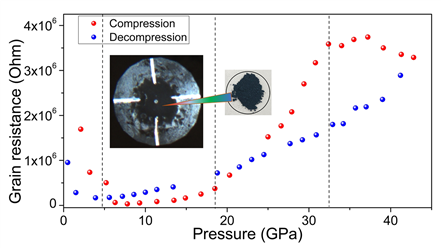Pressure-dependence of Electrical Conductivity of Black Titania – Dr. Hengzhong Zhang
FEBRUARY 13, 2019
New work from a research team led by Dr. Hengzhong Zhang at HPSTAR found that pressure affects the electrical conductivity of black titania via controlling the number of free electrons distributed in the conduction band, which is inversely proportional to the exponent of the bandgap that scales almost linearly with the pressure. This work is published in J. Phys. Chem. C.
Titania finds wide applications in photocatalysis and solar energy conversion. However, its wide bandgap (over 3 eV) and high electrical resistivity constrain its photocatalytic activity and solar-cell efficiency. Hydrogenation of titania (black titania) can enhance the light absorption and electrical conductivity, improving photocatalysis. Pressure is a state variable that can change material structure and properties without changing the composition. To explore how pressure affects the electrical conductivity of black titania, the research team studied the structure changes of the materials at high pressure using synchrotron X-ray diffraction, and measured the Raman/UV-vis spectroscopy and electrical transport properties at high pressure. The structure-property relationship and the mechanism accounting for the pressure effects on the electrical conductivity was explored based on both experimental and computational results.
They found that the observed complex variation of the electrical conductivity of black titania with pressure is attributed to the change in the carrier concentrations due to the changes of the band gaps of involved Ti−O phases under compression. For a specific phase, the higher the pressure, the larger the band gap and hence the higher the electrical resistivity. They also found that high-degree of hydrogenation at a high temperature (800 oC) leads to significant enhancement in the electrical conductivity of the material due to partial formation of a Magneli phase (Ti9O17) that has a mid-band gap of ~1.9 eV. This research provides topical findings related to the pressure dependence of the conductivity of black titania, providing new ideas for tuning electrical transport of semiconductors via bandgap change under compression. It will have important implications for developing new applications of black titania in addition to photocatalysis, such as pressure sensors.

Caption: Pressure-dependence of the resistance of black titania measured from AC impedance spectroscopy.
二氧化钛在光催化和太阳能转换中有着广泛的应用,但其较宽的带隙(大于3eV)和较高的电阻率限制了其光催化活性和太阳能电池的效率。相对于非氢化的氧化钛,氢化后的氧化钛因具有较强的光吸收、电导率和光催化性能而引起了研究人员的广泛关注。北京高压科学研究中心的张衡中研究员带领的研究小组对不同温度下氢化过的黑色二氧化钛进行了高压结构和电学性质的研究,发现了黑色氧化钛的电阻率在高压下的复杂变化与结构相变相对应。由于不同的Ti-O物相对应不同的带隙,黑色氧化钛在高压下导电性的变化归因于带隙变化引起的载流子浓度的变化。这项工作的发现为在压缩条件下通过带隙变化调节半导体的电子输运提供了新思路;对开发除光催化以外的黑色氧化钛的新应用(如压力传感器) 有重要意义。
